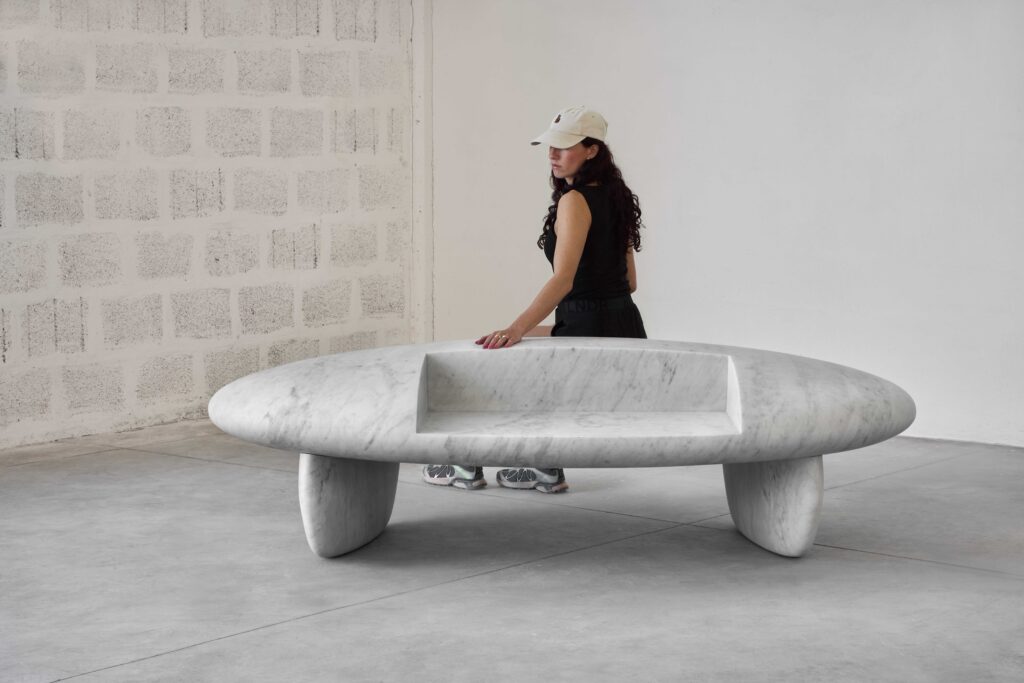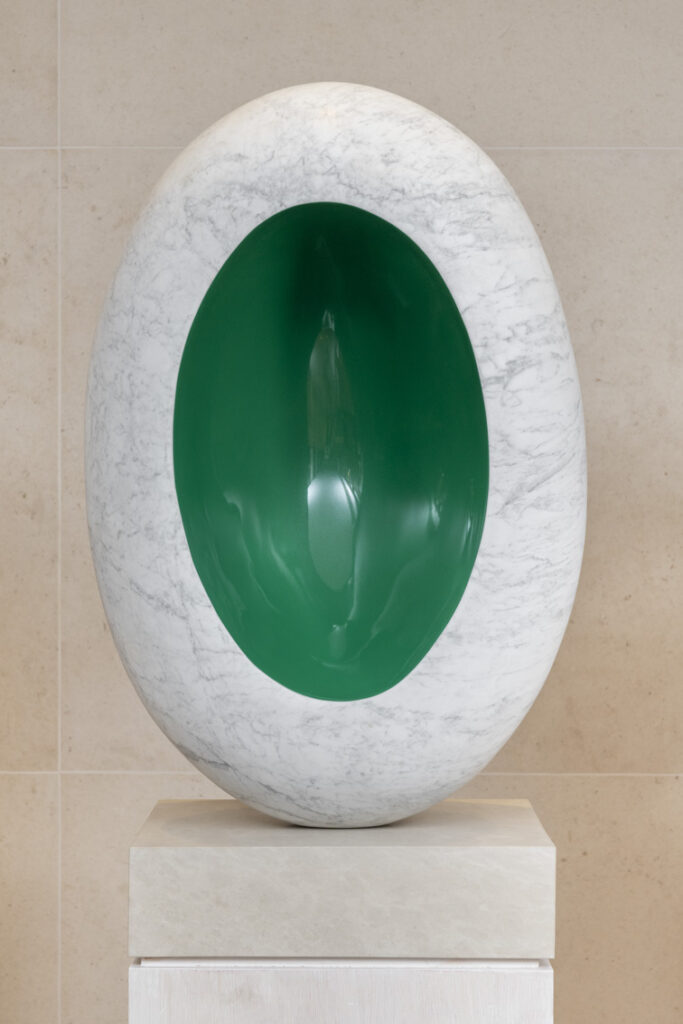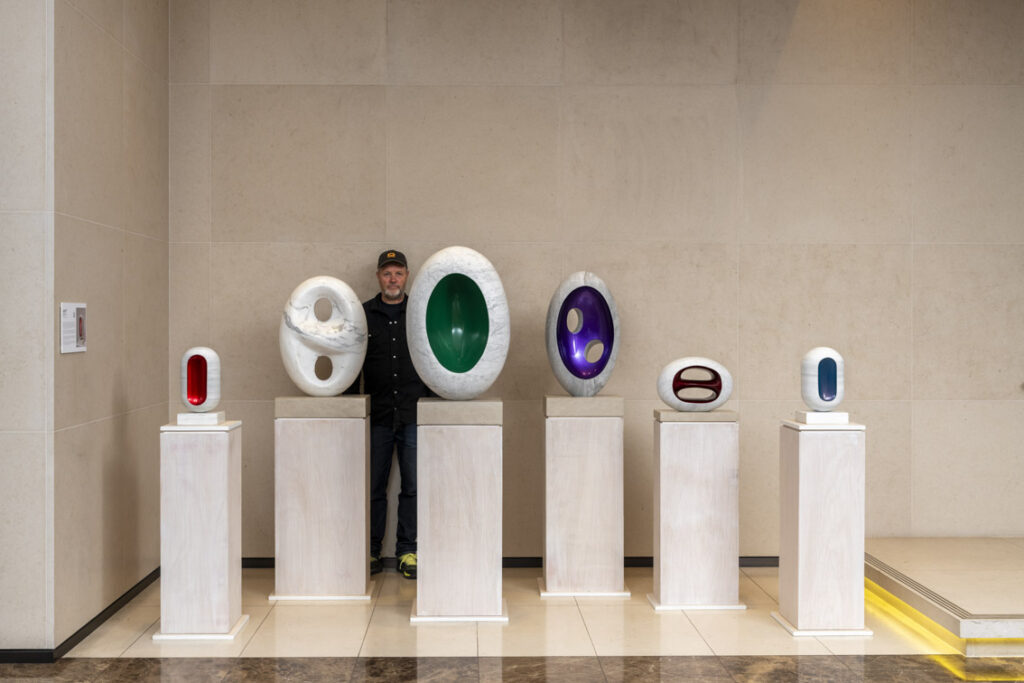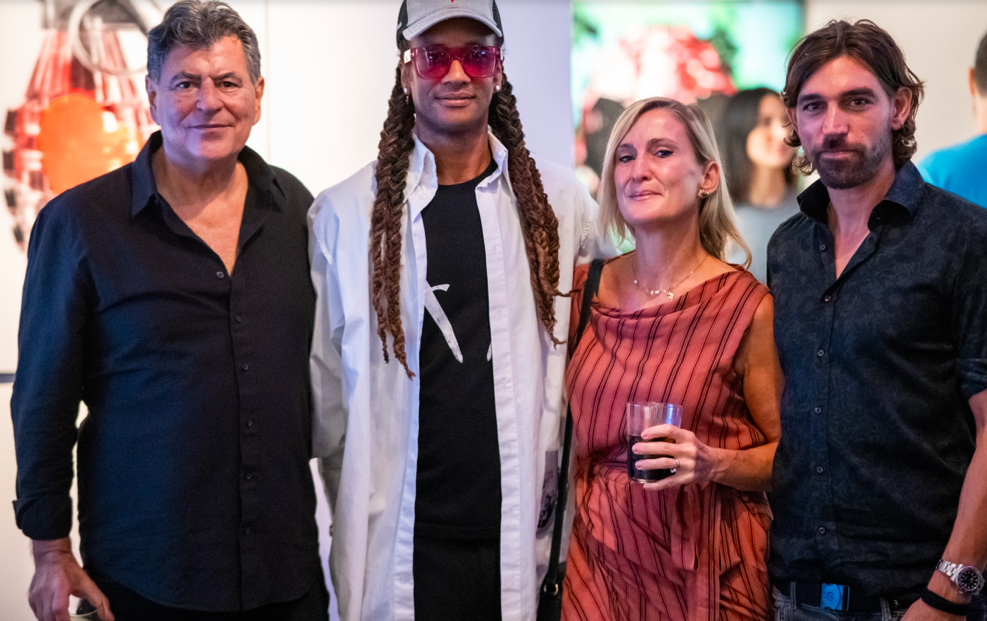David Worthington, British sculptor and fellow of the Royal British Society of Sculptors, is known for his exploration of form, texture, and material, Worthington’s work bridges Modernist design, organic inspiration, and functional art. From his Covent Garden public installation to his new marble and painted sculptures in Mayfair, Worthington reflects on how art, design, and the natural world converge in his practice. He shares insights into how public sculpture can transform space, how tactile interaction shapes meaning, and how influences from Barbara Hepworth, Jean Arp, and Henry Moore continue to inform his pursuit of “significant form.”
This conversation delves into the dialogue between utility and beauty, the future of public art, and the timeless power of sculpture to move us, both physically and emotionally.

Congratulations on your major new public commission at 20 Gresham Street in the City of London. You’ve created enormous travertine stone benches, inspired by organic forms, Modernism, and design, which beautifully blur the line between art and utility. Can you tell us about the concept behind the work, the process of creating them, and how you see them questioning the boundary between sculpture and furniture?
Thank you. For the public commission I created large travertine stone benches from 3 m to 5m, so they are as huge as the lobby is vast. The result is that they are reminiscent of giant sea creatures, whales or sharks. The rich pattern of the stone gives them an ancientness, so they also evoke dinosaurs. At the same time the benches seem to be from the future or from a space movie. This is exactly what I always hope to create: a work drawing from the past, looking to the future and present in the contemporary.
The commission was for utilitarian benches that have a sculptural quality and hold the room through the impact of their forms. I have made hybrid sculptures that cross the barrier between art and design. Interactive stones that spin and can be sat upon. For me the dialogue between art and design in the 20th century is fascinating, and it’s a subject I lecture on. You can see how furniture designers–particularly in Scandinavia–were influenced by Moore and Hepworth, especially in the articulation of arms.
In my generation you can see the influence in reverse with Sarah Lucas using classic mid-century chairs recast in concrete as a base. I have always found the work of Philippe Starck and Marc Newsom very sculptural. In the end we are looking for pure strong form that resonates meaningfuly.
You have an exhibition at 33 Davies Street in Mayfair, showcasing new marble and painted sculptures that integrate sound. Can you share how this idea of bringing sound into your work developed, and what it means to you to make sculpture not only visual and tactile, but also auditory?
These pieces don’t actually have sound. But the inspiration was HiFi design, as I also have a love of sound systems, through nostalgia of being a teenage boy in his room listening to music. The lines and forms of minimal HIFi designs like Dieter Rams and B&W Pod Speakers have inspired me. My first investigations using colour on marble mimicked their forms, taking us away from stone’s aspirational interior design qualities.

I liked how my contemporaries such as Sean Henry, Julian Wild Ekkehradt Altenberger and Owen Bullett were using colour. We now know that ancient sculpture was painted from ancient times through to medieval. It was only during the Renaissance when the Classical pieces were dug up with much of the colour gone, that the style changed to plain white marble. My use of colour aims to contemporize this loaded material by using vibrant shimmering paint more from the worlds of disco music, car design and Seventies fashion. I have continued with the HiFi theme by making a functioning speaker and amplifier that acted as commentary on the relationship between art and design.

You’ve created several large-scale public commissions, including your Covent Garden installation of one large “boulder” and five smaller “pebbles” in red travertine. How do you approach interpreting and responding to different public spaces, and what roles do you think sculpture can play in shaping how people move through and experience those environments?
With each commission there is usually a very clear brief from the client. For instance, in my public commission in Great Queen St, Covent Garden, the developers wanted people to be able to perch on the sculptures but not to deal drugs! There had been a gang gun fight there weeks before.
What I find interesting about public art is how it alters the geography and sense of space. Even if people don’t necessarily look at the sculpture, they react to it. Right after the pebbles were installed, a businessman went up to one, put his bag down and started looking around as if were searching for someone. As an animal we are magnetised by place and things such as rocks and trees. Sculpture acts as an anchor in the public realm, and as a place of safety. I have seen how a space such as car park in front of a house can be transformed by a sculpture. The environment seems to orbit around it. It creates a dynamism, and that is why landscape artists have been placing statues in gardens since the Renaissance.

Your work is deeply influenced by form, texture, and the natural world, yet it also draws on design, industry, and even science fiction. How do these diverse influences, from the Dorset landscape to 1960s modernism, shape the way you think about material, space, and the idea of objects “taking up space”?
As I said, design has been a formative influence (on my practice) but so has nature. I was born and grew up in London in the Sixties and saw mid-century Modernism literally being built in front of me. There was an optimism and positivity that modern design seemed to promote. A New World. The Sci Fi TV shows of the Sixties were very much part of my childhood. In fact, Tracey Island from Thunderbirds is a mid-Century Modern dreamscape.
At the same time I also visited my relations in the country, and my grandmother and Aunt happened to live on the Sussex Downs. Then my grandmother moved to Wiltshire–also on the Downs–and when my father re-married we moved to West Dorset where I now live (which is also on the Downs). The forms of the these rolling hills: soft and gentle, yet striking and delineated, made a great impression on me. And in that landscape are prehistoric archaeological sites from Old Sarum and Stonehenge to the Neolithic fortresses of Dorset. Human intervention in the landscape has stayed with me, and when I discovered US Land art of the Sixties, it felt so familiar. Robert Smithson visited Chisel Bank in Dorset only a few miles from where I live in 1969. When I discovered Modernist sculpture and design, I recognised that the geology of England was similar.
You’ve spoken about sculpture as something our bodies understand before our minds. Do you think physical engagement, scale, and touch influence the way you conceive and finish your sculptures, especially those designed for public interaction?
Touch is essential to sculpture, but unfortunately if it’s a public collection conservation stops that. At St Peter’s Cathedral in Rome, there is a Romanesque statue of the Saint whose big toe has been flattened from a century of pilgrims touching it. For me, interaction between the object and the audience is crucial. We want to embrace a sculpture like hugging boulders, and with my spinning interactive stone you can not only touch but climb upon them.
I also believe that we respond to art subconsciously. When you stand next to a sculpture your physical body is responding to another body in space, in size, scale and material. And these interactions create meaning, not a conceptual statement but meaning that has references to the rest of your daily life, like the handrail in a house, the floor of an office or the cup you use every day. Sculptors are using a language of material and form to communicate. Not statements but expressions about life and the world we are navigating. Minimalist composers used the sounds of the city and repetition to do the same. Gratifyingly, I found a quote from Franz West where he says something similar. We walk around the sculpture looking, one body to another.

From Barbara Hepworth and Jean Arp, your artistic lineage is remarkable. How did those early experiences and mentors shape your understanding of form and material, and in what ways do you continue to carry their influence into your own practice today?
From an early age I responded to form, whether it was the concave nose of Thunderbirds 2 to the hills around me, and when I saw the work of Barbara Hepworth, Brancusi and Jean Arp, I had the same sensation.
I met Henry Moore when I was 17 at his studio. Aged 18 in New York, I worked on a photomontage for Mike Heizer. Form is glorious and satisfying. A curve well fashioned is delicious like a good pasta dish with white truffles. In my work I am trying every time to find significant form that I interpret as the sculptural forms we observe in the world around us
What is the difference between sculpture and design? Intention and reception. A shape, a line or a contour that feels complete and right in that instance. Anti-object artists in the 1960s toppled sculpture from its pedestal. Its spirit retreated into the world of design where designers were able to create pure form without fear. I believe in sculpture and the sculptural. That our need for sculpture is as profound as our need for music and dance. Sculpture acts on the nervous system without needing words. Societies erect sculptures as acts of will, energy and as a need to say I am here, we are here and this is us.
Find out more about David Worthington here.



